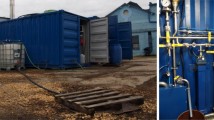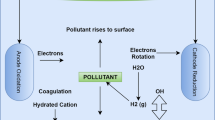Abstract
Metal plating industry wastewater is a highly toxic wastewater due to its heavy metal and cyanide. This characteristic of wastewater is due to different types of processes used in the metal plating industry. In order to meet discharge limits for the receiving environment, classical chemical treatment methods are widely applied in this type of industry. Consequently, high treatment chemicals are required, resulting in excessive amounts of hazardous sludge. For these reasons, in this study, a pilot scale electrocoagulation (EC) process was developed as an alternative to the conventional chemical treatment currently applied in a metal plating plant. In this study, the effect of pH adjustment on the removal efficiency of the EC process was investigated before and after EC processing in a pilot scale reactor. Particularly, two heavy metals such as copper (Cu) and nickel (Ni), which are problematic to be eliminated in the current treatment, removals were invesigated. With the optimization studies, it was observed that Cu and Ni removals were over 93.75%. Similarly, Cu and Ni removal efficiencies were determined over 95% in the optimization of the EC process after pH adjustment. Indeed, these efficiencies were also achieved in the control study. As a result of the optimization of the study, model analyses were made with response surface methodology and it was observed that the regression coefficients were > 94.00% which were within the 95% confidence interval. This indicated that both the real operating conditions and the results obtained from the model are consistent with each other.
Graphical abstract










Similar content being viewed by others
References
Abdel-Shafy HI, Morsy RMM, Hewehy MAI, Razek TMA, Hamid MMA (2022) Treatment of industrial electroplating wastewater for metals removal via electrocoagulation continous flow reactors. Water Pract Technol 17(2):555–566. https://doi.org/10.2166/wpt.2022.001
Ahmad MK, Mohammed MA, Barbooti MM (2020) Electrocoagulation for the removal of copper and zinc ions from water using iron electrodes. Open Chem J. https://doi.org/10.2174/1874842202007010037
Ahmad Tajudin SA, Azim MAM, Syakeera NN, Jefferson I, Rogers C (2017) Application of electrokinetic stabilisation (EKS) method for soft soil: a review. IOP Conf Ser Mater Sci Eng 226:012075. https://doi.org/10.1088/1757-899X/226/1/012075
Akbal F, Camci S (2010) Comparison of electrocoagulation and chemical coagulation for heavy metal removal. Chem Eng Technol 33(10):1655–1664. https://doi.org/10.1002/ceat.201000091
Akbal F, Camci S (2011) Copper, chromium and nickel removal from metal plating wastewater by electrocoagulation. Desalination 269(1–3):214–222. https://doi.org/10.1016/j.desal.2010.11.001
Akbal F, Camcı S (2011) Copper, chromium and nickel removal from metal plating wastewater by electrocoagulation. Desalination 269(1):214–222. https://doi.org/10.1016/j.desal.2010.11.001
Al-Qodah Z, Al-Shannag M (2017) Heavy metal ions removal from wastewater using electrocoagulation processes: a comprehensive review. Sep Sci Technol 52(17):2649–2676. https://doi.org/10.1080/01496395.2017.1373677
Al-Shannag M, Al-Qodah Z, Bani-Melhem K, Qtaishat MR, Alkasrawi M (2015) Heavy metal ions removal from metal plating wastewater using electrocoagulation: kinetic study and process performance. Chem Eng J 260:749–756. https://doi.org/10.1016/j.cej.2014.09.035
Aziz NH, Shahin AAM, Abou-Zeid AAM, El-Zeany SA (2000) Correlation of growth and aflatoxin production by Aspergillus flavus with some essential metals in gamma irradiated crushed corn. Nahrung Food 44(5):354–359. https://doi.org/10.1002/1521-3803(20001001)44:5%3c354::aid-food354%3e3.0.co;2-4
Batista HS, Graczyk T (2013) An analysis of the welding-induced deformation of ship panels using a statistical tool. Polish Maritime Res 20(2):74–81
Bayramoglu M, Eyvaz M, Kobya M (2007) Treatment of the textile wastewater by electrocoagulation Economical evaluation. Chem Eng J 128(2–3):155–161. https://doi.org/10.1016/j.cej.2006.10.008
Beyazit N (2014) Copper(II), Chromium(VI) and Nickel(II) Removal from Metal Plating Effluent by Electrocoagulation. Int J Electrochem Sci 9(8):4315–4330
BrbootI MM, AbiD BA, Al-ShuwaikI NM (2011) Removal of heavy metals using chemicals precipitation. Eng Technol J 29(3):595–612
Canizares P, Martinez F, Jimenez C, Saez C, Rodrigo MA (2009) Technical and economic comparison of conventional and electrochemical coagulation processes. J Chem Technol Biotechnol 84(5):702–710. https://doi.org/10.1002/jctb.2102
Carolin CF, Kumar PS, Saravanan A, Joshiba GJ, Naushad M (2017) Efficient techniques for the removal of toxic heavy metals from aquatic environment: a review. J Environ Chem Eng 5(3):2782–2799. https://doi.org/10.1016/j.jece.2017.05.029
Chen GH (2004) Electrochemical technologies in wastewater treatment. Sep Purif Technol 38(1):11–41. https://doi.org/10.1016/j.seppur.2003.10.006
Coskun T, İlhan F, Demir NM, Debik E, Kurt U (2012) Optimization of energy costs in the pretreatment of olive mill wastewaters by electrocoagulation. Environ Technol 33(7):801–807. https://doi.org/10.1080/09593330.2011.595829
Eaton AD, Clesceri LS, Franson MAH, Association APH, Greenberg AE, Rice EW, Federation WE (2005) Standard methods for the examination of water & wastewater: American public health association
Emamjomeh MM, Sivakumar M (2009) Review of pollutants removed by electrocoagulation and electrocoagulation/flotation processes. J Environ Manag 90(5):1663–1679. https://doi.org/10.1016/j.jenvman.2008.12.011
Fung KY, Wibowo C (2013) Design of industrial wastewater treatment plants: a multi-faceted problem. Curr Opin Chem Eng 2(4):455–460. https://doi.org/10.1016/j.coche.2013.09.003
Ghaferi Z, Sharafi S, Bahrololoom ME (2017) Characterization of Co–Fe magnetic films fabricated by galvano-static electrodeposition. Iran J Mater Sci Eng 14(2):60–70. https://doi.org/10.22068/ijmse.14.2.60
Harif T, Khai M, Adin A (2012) Electrocoagulation versus chemical coagulation: coagulation/flocculation mechanisms and resulting floc characteristics. Water Res 46(10):3177–3188. https://doi.org/10.1016/j.watres.2012.03.034
Hosseini SS, Bringas E, Tan NR, Ortiz I, Ghahramani M, Shahmirzadi MAA (2016) Recent progress in development of high performance polymeric membranes and materials for metal plating wastewater treatment: a review. J Water Process Eng 9:78–110. https://doi.org/10.1016/j.jwpe.2015.11.005
Ilo OP, Nkomo SPL, Mkhize NM, Mutanga O, Simatele MD (2022) Optimisation of process parameters using response surface methodology to improve the liquid fraction yield from pyrolysis of water hyacinth. Environ Sci Pollut Res. https://doi.org/10.1007/s11356-022-22639-z
Ithan F, Ulucan-Altuntas K, Avsar Y, Kurt U, Saral A (2019) Electrocoagulation process for the treatment of metal-plating wastewater: kinetic modeling and energy consumption. Front Environ Sci Eng. https://doi.org/10.1007/s11783-019-1152-1
Kabuk HA, Avsar Y, Ilhan F, Ulucan K (2014) Comparison of pH adjustment and electrocoagulation processes on treatability of metal plating wastewater. Sep Sci Technol 49(4):613–618. https://doi.org/10.1080/01496395.2013.839705
Karunakaran A, Chaturvedi A, Ali J, Singh R, Agarwal S, Garg MC (2022) Response surface methodology-based modeling and optimization of chromium removal using spiral-wound reverse-osmosis membrane setup. Int J Environ Sci Technol 19(7):5999–6010. https://doi.org/10.1007/s13762-021-03422-y
Kobielska PA, Howarth AJ, Farha OK, Nayak S (2018) Metal-organic frameworks for heavy metal removal from water. Coord Chem Rev 358:92–107. https://doi.org/10.1016/j.ccr.2017.12.010
Kobya M, Demirbas E, Ozyonar F, Sirtbas G, Gengec E (2017) Treatments of alkaline non-cyanide, alkaline cyanide and acidic zinc electroplating wastewaters by electrocoagulation. Process Saf Environ Prot 105:373–385. https://doi.org/10.1016/j.psep.2016.11.020
Kurt U, Gonullu MT, Ilhan F, Varinca K (2008) Treatment of domestic wastewater by electrocoagulation in a cell with Fe–Fe electrodes. Environ Eng Sci 25(2):153–161. https://doi.org/10.1089/ees.2006.0132
Lee CG, Lee S, Park JA, Park C, Lee SJ, Kim SB, Choi JW (2017) Removal of copper, nickel and chromium mixtures from metal plating wastewater by adsorption with modified carbon foam. Chemosphere 166:203–211. https://doi.org/10.1016/j.chemosphere.2016.09.093
Li F, Du P, Chen W, Zhang SS (2007) Preparation of silica-supported porous sorbent for heavy metal ions removal in wastewater treatment by organic-inorganic hybridization combined with sucrose and polyethylene glycol imprinting. Anal Chim Acta 585(2):211–218. https://doi.org/10.1016/j.aca.2006.12.047
Likon M, Zemljič M (2020) Does sustainable management of biodegradable sludge exist at all? A BACOM project case
Lu X, Xu T, Zhou Y, Peng Q, Ou J, Hu B, Yu G (2023) Effect of iron ion configurations on Ni2+ removal in electrocoagulation. J Environ Sci 124:823–834. https://doi.org/10.1016/j.jes.2022.01.037
Mollah MYA, Schennach R, Parga JR, Cocke DL (2001) Electrocoagulation (EC)-science and applications. J Hazard Mater 84(1):29–41. https://doi.org/10.1016/s0304-3894(01)00176-5
Moussa DT, El-Naas MH, Nasser M, Al-Marri MJ (2017) A comprehensive review of electrocoagulation for water treatment: potentials and challenges. J Environ Manag 186:24–41. https://doi.org/10.1016/j.jenvman.2016.10.032
Nizamuddin S, Mubarak NM, Tiripathi M, Jayakumar NS, Sahu JN, Ganesan P (2016) Chemical, dielectric and structural characterization of optimized hydrochar produced from hydrothermal carbonization of palm shell. Fuel 163:88–97. https://doi.org/10.1016/j.fuel.2015.08.057
Piri S, Mehranbod N, Moussavi M, Mirsoleimani-azizi SM (2020) Application of response surface method for removal of Cr(VI) from aqueous solutions using foam fractionation process. Int J Environ Sci Technol 17(1):321–332. https://doi.org/10.1007/s13762-019-02349-9
Poges S, Jin J, Guild C, Li WN, Birnkrant M, Suib SL (2018) Preparation and characterization of aluminum coatings via electroless plating onto nickel nanowires using ionic liquid plating solution. Mater Chem Phys 207:303–308. https://doi.org/10.1016/j.matchemphys.2017.12.079
Priya RG, Basha CA, Ramamurthi V, Begum SN (2009) Recovery and reuse of Ni(II) from rinsewater of electroplating industries. J Hazard Mater 163(2–3):899–909. https://doi.org/10.1016/j.jhazmat.2008.07.072
Rastegar SO, Mousavi SM, Shojaosadati SA (2014) Cr and Ni recovery during bioleaching of dewatered metal-plating sludge using acidithiobacillus ferrooxidans. Biores Technol 167:61–68. https://doi.org/10.1016/j.biortech.2014.05.107
Scarazzato T, Buzzi DC, Bernardes AM, Espinosa DCR (2015) Treatment of wastewaters from cyanide-free plating process by electrodialysis. J Clean Prod 91:241–250. https://doi.org/10.1016/j.jclepro.2014.12.046
Sciscenko I, Pedre I, Hunt A, Bogo H, González GA (2016) Determination of a typical additive in zinc electroplating baths. Microchem J 127:226–230. https://doi.org/10.1016/j.microc.2016.03.015
Shaheen N, Irfan NM, Khan IN, Islam S, Islam MS, Ahmed MK (2016) Presence of heavy metals in fruits and vegetables: health risk implications in Bangladesh. Chemosphere 152:431–438. https://doi.org/10.1016/j.chemosphere.2016.02.060
Shao ZC, Cai ZQ, Hu R, Wei SQ (2014) The study of electroless nickel plating directly on magnesium alloy. Surf Coat Technol 249:42–47. https://doi.org/10.1016/j.surfcoat.2014.03.043
Sun J, Yang Y, Wang D (2013) Parametric optimization of selective laser melting for forming Ti6Al4V samples by Taguchi method. Opt Laser Technol 49:118–124. https://doi.org/10.1016/j.optlastec.2012.12.002
Vigneswaran C, Anbumani N, Ananthasubramanian M, Rajendran R (2012) Prediction of optimum process parameters to achieve eco-friendly desizing of organic cotton fabrics with indigenously produced alpha-amylase and their enzyme kinetics. J Textile Inst 103(4):422–433. https://doi.org/10.1080/00405000.2011.581359
Wijenberg J, Steegh M, Aarnts MP, Lammers KR, Mol JMC (2015) Electrodeposition of mixed chromium metal-carbide-oxide coatings from a trivalent chromium-formate electrolyte without a buffering agent. Electrochim Acta 173:819–826. https://doi.org/10.1016/j.electacta.2015.05.121
Williams-Beam C, Twidwell L G (2003, Aug 24–27). Removal of thallium from wastewater. In: Paper presented at the 5th international symposium on hydrometallurgy in honor of Ian M Ritchie, Vancouver, Canada
Yavuz Y, Ogutveren UB (2018) Treatment of industrial estate wastewater by the application of electrocoagulation process using iron electrodes. J Environ Manage 207:151–158. https://doi.org/10.1016/j.jenvman.2017.11.034
Yuksel E, Gurbulak E, Eyvaz M (2012) Decolorization of a reactive dye solution and treatment of a textile wastewater by electrocoagulation and chemical coagulation: techno-economic comparison. Environ Prog Sustain Energy 31(4):524–535. https://doi.org/10.1002/ep.10574
Acknowledgements
The authors received research grants from the Research Fund of the Republic of Turkey Ministry of Industry and Technology with a Project Number 0274.STZ-2013-2.
Author information
Authors and Affiliations
Corresponding author
Ethics declarations
Conflict of interest
The authors have no conflicts of interest to declare.
Additional information
Editorial responsibility: Shahid Hussain.
Rights and permissions
Springer Nature or its licensor (e.g. a society or other partner) holds exclusive rights to this article under a publishing agreement with the author(s) or other rightsholder(s); author self-archiving of the accepted manuscript version of this article is solely governed by the terms of such publishing agreement and applicable law.
About this article
Cite this article
Ilhan, F., Avsar, Y., Kurt, U. et al. Optimization and effect of pH on treatability of metal plating wastewater by electrocoagulation process: a pilot study. Int. J. Environ. Sci. Technol. 20, 7671–7688 (2023). https://doi.org/10.1007/s13762-023-04972-z
Received:
Revised:
Accepted:
Published:
Issue Date:
DOI: https://doi.org/10.1007/s13762-023-04972-z




